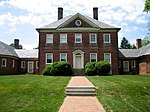Special Collection Service
1978 establishments in the United StatesBeltsville, MarylandCentral Intelligence AgencyNational Security AgencySecret places in the United States ... and 1 more
Signals intelligence

The Special Collection Service (SCS), codenamed F6, is a highly classified joint U.S. Central Intelligence Agency–National Security Agency program charged with inserting eavesdropping equipment in difficult-to-reach places, such as foreign embassies, communications centers, and foreign government installations. Established in the late 1970s and headquartered in Beltsville, Maryland, the SCS has been involved in operations ranging from the Cold War to the Global War on Terrorism.
Excerpt from the Wikipedia article Special Collection Service (License: CC BY-SA 3.0, Authors, Images).Special Collection Service
Springfield Road,
Geographical coordinates (GPS) Address Nearby Places Show on map
Geographical coordinates (GPS)
| Latitude | Longitude |
|---|---|
| N 39.045 ° | E -76.857 ° |
Address
Springfield Road
20708
Maryland, United States
Open on Google Maps







